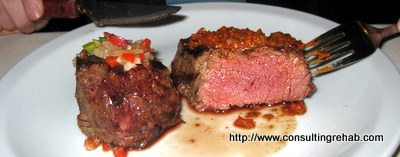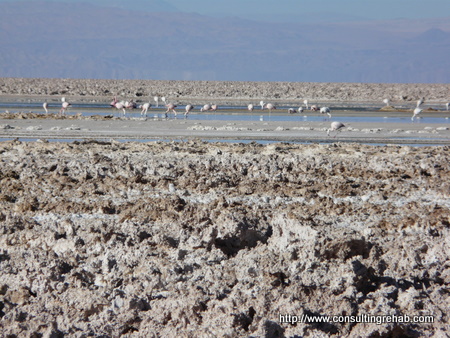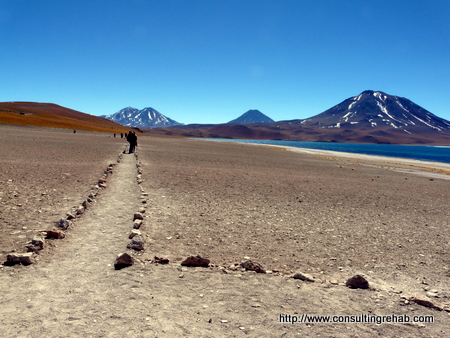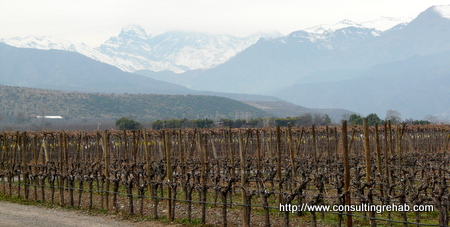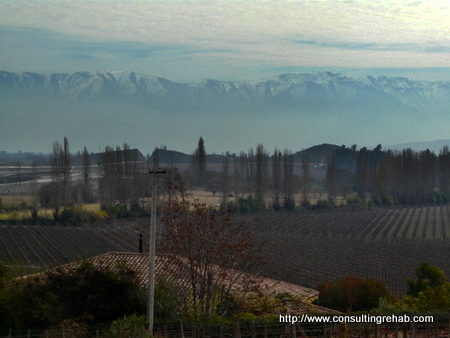2 cities enter. One city leaves.
Will it be Santiago, Chile – the home of enormous mayo covered hot dogs and some of the most impressive mountain views anywhere in the world?
or
Will it be Buenos Aires, Argentina -where you can (and more or less have to) eat steak 5+ times a week?
We spent 6 months researching–4.5 months in Buenos Aires and 1.5 months in Santiago–in an attempt to answer this frequently asked and extremely difficult question: If you’re headed to the Southern Cone, which of these 2 great cities should you prioritize?
Last week we covered the food category and while Santiago had a strong showing and was far and away the winner on diversity of food options, we declared Buenos Aires the winner for the Food category overall – they may have limited menu options, but damn do they do them well. Check out the full review of Buenos Aires vs. Santiago food.
We’re ready to move on. Today’s category is…
2. Drink
This category is almost as important as food and despite bottles and bottles of intensive research, it is very difficult to declare a winner. Let’s start with wine.
Category 1) Wine: Winner – Buenos Aires/Argentina (though these are 2 of the best countries in the world to drink wine)
This is not really a Santiago vs. Buenos Aires thing, but rather a Chile vs. Argentina thing. Both Argentina and Chile are deservedly proud of their wine traditions and more and more, they are gaining attention internationally for the quality of the wines they produce. Both are pretty damn good and we had a rather fantastic (though for some reason, difficult to remember) time researching this category 🙂 By the way, if you are in Buenos Aires and like wine, you should do a wine tasting with Anuva – check out our original review on them for details: Review of Anuva Wine tasting in Buenos Aires: Do it, you’ll thank us
In both countries, most wine is grown right along the Andes with the largest regions being almost directly across the mountains from one another (Mendoza, Argentina and the many regions surrounding Santiago). After visiting wineries in both of these regions and doing some additional research (Jen had to write a report for Spanish class on something…), we learned that while the regions are quite close geographically, being east vs. west of the mountains actually leads to some pretty significant differences in grape growing conditions – one of the largest differences being that on the Argentina side, the climate is quite a bit drier. This and other differences lead to different types of grapes being better suited to one side vs. the other. It’s why Argentina dominates global Malbec productions and is one of the only regions in the world to produces Torrontes and why Chile tends to export a broader array of both red and white varietals including the Carmenere which is largely exclusive to Chile. Before we get into our sub-sub-category ratings, let’s start with some context on both regions.
Context
Argentine Wine Industry:
Argentina is currently the world’s 5th largest wine producer. The vast majority of the wine produced in Argentina stays in Argentina – currently only somewhere between 20% and 30% is exported. Up until the 1970s, Argentina produced more wine than pretty much any other country in the world. They were apparently producing 22 tons per acre whereas most quality wine regions in France and California at the time were only producing ~2-5 tons per acre. How did they do it? Three words:
1) Super
2) low
3) quality
Everyone used to have a big jug that they would go fill up every couple of days in the middle of town at a big wine keg type thing. It was called “vino de mesa,” or “table wine.” Back then, Argentines were drinking more wine per capita than any other country in the world (seriously, they were drinking something like 24 gallons/year/person on average vs. less than 1 gallon/person in countries like the US and UK), but virtually none of it was exported because, you know, it sucked.
It wasn’t until the 1990s that international wine experts started taking a closer look at Argentina. After seeing the soil conditions, the lack of humidity, the lack of pests and the altitude, there began to be a lot of talk about the incredible potential Argentina had to produce top quality premium wines. Slowly over the last couple of decades more and more of the industry has changed their practices away from mass produced low quality table wine to export-ready premium wine. This has been largely driven by foreign investment. When we were in Mendoza, we were told that back in 2002-2003 after the most recent Argentine economic collapse, there was an average of something like 3 new wineries opening every day as foreigners took advantage of low prices and saw an opportunity to make great wine. This process still has a long way to go as they still only export a small fraction of the wine produced, but I think we can expect to see more and more Argentine wines in the international market in the years to come. It is also worth noting, that the days of jug-wine are for the most part gone in Argentina and now even most of the wine produced for domestic consumption is quite high quality.
Chilean Wine Industry:
Chile produces only a little more than half of the total wine that Argentina does and drinks only a small fraction of the wine that they produce; they export the rest. In fact, they export 70+% of the wine that they produce which, despite the relatively small size and population of the country, makes them the 5th largest wine exporting country in the world (under France, Italy and Australia – Argentina is #8 at about 63% of the export volume of Chile). It wasn’t always this way. Similar to Argentina, the wine industry in Chile largely produced low quality wines for domestic consumption up until the 1980s. Once they solved some political and economic issues, they recognized that they had the potential to turn wine into a big business, and they did. Starting back in the 80s, they began using modern wine techniques from around the world and geared up their wineries to start producing great quality wines designed primarily for export. They rapidly climbed the export rankings and continue to be one of the biggest exporters in the world.
You may have seen our earlier post on our visit to the Concha y Toro winery in Santiago – it’s the largest winery in Latin America and the 8th largest in the world.

You may recognize these labels... they are sold all over the world
Why am I telling you all of this?
I’m not sure really. The important thing to remember is this… Chile is big in the business of exporting wine and Argentina is big on the tradition of making and drinking wine. They both make great wine, but this context leads to some different outcomes.
Enough information, onto our totally subjective opinions…
Sub-category 1) White wine – Winner: Chile (by a lot)
Argentina: Our experience was that Argentina focuses far more on red wine, and while we did find one Chardonnay that we liked, the vast majority of the whites that we tried there we thought were terrible. Obviously this is subjective, but I’ve yet to hear anyone rave about a white Argentine wine nor have I ever seen one for sale in the US – if you have a different opinion, please let us know. There is an exception to this… Northwestern Argentina is quite proud of their own unique white varietal known as Torrontes. Many people talk it up as being a fantastic alternative to the more traditional varietals and the Argentines from the region (Salta) beam with pride whenever it is discussed. We wanted to like Torrontes. We really did. Sadly, we could not. After tasting several versions of it at a few of the wineries in Cafayate, the best way we can describe it is that it smells like very sweet dessert wine, yet somehow tastes like water. It’s not that it’s bad, it’s just that it’s not good.
Chile: Chile has fantastic white wines. Virtually every white that we tried there we thought was excellent and if you are ever staring at the 100s of bottles of wine in a liquor store wondering what Chardonnay to buy, your odds of picking a good one are pretty good if you grab pretty much anything from Chile.
Sub-category 2) Red wine – Winner: Too close to call
This is too close to call. They both have fantastic red wines. Some of the Malbecs from Argentina are absolutely amazing (others taste like kool-aid) and Chile has some fantastic big Cabs, Syrahs and others. We are going to take a pass on this one. Suffice to say, you can acquire fantastic red wine in either country.
The difference is in how much you have to pay for it, which leads us to the next category…
Sub-category 3) Value for $ – Winner: Argentina
Value for the money is a pretty important dimension in determining what wine you’ll actually be able to try wherever you go and a big part of the reason why I provided so much context on the histories of the wine industries in each country up front.
Chile: Prices in general are a bit higher in Chile than Argentina for pretty much everything at the moment (though, with ~30% inflation per year, Argentina is rapidly catching up – until the next economic crisis). The difference in wine prices is remarkable. The reason for this is that Chilean wine is for the most part produced for export and priced at export pricing levels – we often saw the same bottles of Chilean wine that we’d bought here in the US for sale in Chile at the same or higher prices. It’s not that it’s super expensive, it’s just that it’s internationally priced. Argentina is different.
Argentina: Argentina exports only a small fraction of their wine and that wine is often labels that aren’t even sold domestically, so when you go to buy wine in Argentina, you are confronted with prices that were designed entirely for the local, relatively low-income, wine-loving market. The vast majority of the wines in any store are priced at AR$15-30 which is US$3-7. The staple wine that we drank all the time in Buenos Aires literally cost ~US$4/bottle. That wine was awesome, and a bottle of that quality would easily cost $15-20 in the US (or Chile for that matter). The value got even better if you were willing to spend a little bit more… we took back with us a few extremely expensive (on Argentine standards) bottles of wine that are easily some of the best wine we’ve ever had (and when we were consultants, people used to give us some pretty fancy wine from time to time!) – these super expensive bottles cost ~US$20, I’d put them in the ~US$100 range for something of similar quality here in the US. Another great thing is that it’s easy to experiment with different high-end bottles in restaurants as the mark-up tended to be only 10-20% over store prices vs. the 2-3x mark-up that is common in the US (Chile also had a high restaurant mark-up).
On value for $, Argentina is impossible to beat.
Sub-category 4) Variety of new wines to try in-country: Argentina
There is no question that Chile has great wines, but because they export so much of their wine, the wines that you’ll see in Santiago are pretty much the exact same wines that you’ll see in the Chilean section of a wine store in the US. I’m sure that there are wines that you have to be in the country to experience, but in general, you can sample most of the Chilean wines from pretty much anywhere in the world.
On the flip-side, the vast majority of Argentine wines are currently impossible to purchase outside of the country. You can be certain that a trip to Buenos Aires will expose you to an awesome variety of wines that you’ve never seen before.
Category 2) National drink: Winner – Santiago (by miles and miles)
Chile: Chile’s national drink (other than Nescafe) is the Pisco Sour. It’s made from Pisco which is a grape based liquor and varying forms of sour mix. Often there is egg white put on top, but the Chilean version usually skips that part. It’s important to note that Pisco Sours are also very popular in other parts of Latin America (most notably Peru), but the Chilean version is their own. The Pisco sour has the remarkable quality of tasting almost non-alcoholic – kind of like lemonade – yet having the ability to absolutely knock you on your ass in a very short period of time. They vary in alcohol content depending on the type of Pisco used, but at one venue we had one drink each at around 5pm and were not able to walk straight again for about 4 hours. The girl we were with threw up upon walking out of the bar. After one drink. Three hours later, we still wished that we had thrown up wih her. They are dangerous, but we love Pisco Sours.
Argentina: Buenos Aires has an obsession with a very special kind of liquor called Fernet. It’s made out of grapes and a variety of spices. It’s often mixed with Coca Cola. We tried a Fernet and Coke one time while in Buenos Aires. Despite the fact that it was mixed with a fair amount of Coca Cola we could not drink more than a few sips. It was without question the worst tasting thing we have ever put in our mouths. This is of course subjective; there are many, many people that claim to love this drink – we suspect this is merely a form of hazing.
Category 3) Coffee: Winner – Buenos Aires (unless you are looking for a little something extra with your coffee..)
It may seem odd to have a category devoted to coffee, but the coffee/cafe cultures in these two cities are so remarkably different, we thought it was worth mentioning. For us, we preferred the leisurely cafe experiences in Buenos Aires, but to each their own as these are very, very different. Here’s the deal…
Buenos Aires: Cafes are a big deal in Buenos Aires. The strong Italian roots of the city are likely the reason behind the strength of the cafe culture. There are usually several cafes on every block and for the most part, they all serve fresh ground, strong and quite tasty coffee. The standard ‘cafe’ is actually what we would call an espresso shot in the US, but there are several variations involving more or less amounts of milk (e.g., cafe con leche, cortado, lagrima). It’s all good. Pretty much any cafe you go to will serve some cookies and a glass of water with every coffee you order. The locals spend lots of time hanging out in cafes sipping their espresso and reading the news. There is no such thing as a to-go cup… when you’re going to have coffee in Buenos Aires, you are going to sit down and drink it for as long as it takes. That’s just how it’s done. Coffee is a big part of the culture here and a good deal of pride is taken not only in producing top quality drinks, but also in providing a great cafe experience. If you’re in a hurry, it can be pretty difficult to get a quick cup of caffeine in this city, but then again we found that we were rarely in a hurry in BsAs.
Santiago: The cafe culture is very different in Santiago. There are 3 main differences: Experience, quality and legs.
1) Experience: There are still many cafes, but for the most part they are designed for getting a quick cup of coffee rather than as places to leisurely hang out for a couple of hours. In fact, a large percentage of the cafes downtown don’t even have seating… everyone just quickly drinks their coffee while standing at a bar. We found that getting coffee was typically a 10 minute experience. This is not really better or worse than the BsAs style, just different. On top of that though, we also found that many of the cafes were favorite destinations of smokers and sometimes there was so much smoke billowing out of them that we couldn’t breathe. Starbucks is actually doing quite well in Santiago and many of the people we talked to suggested that a big part of their success might be that they are one of the few non-smoking cafes.
2) Quality of coffee: For various historical reasons which we never quite fully understood, Chile has a national obsession with Nescafe instant coffee. Upon ordering coffee, the default offering you will get even in a fancy hotel or restaurant will be an empty cup and a plastic single-serve container of Nescafe. After which, they will offer to fill your cup with either hot water or hot milk. While instant coffee can be convenient when you need some coffee and don’t have any alternatives, it seems odd to order coffee in a coffee shop and get it. To be clear, you can definitely order an espresso drink if you’re in the right kind of place, it’s just not the standard-Nescafe is everywhere.
3) Legs: We covered the Coffee with Legs/Cafe con piernas phenomenon at length in a previous post (see it here: Cafe con piernas = coffee with legs). Coffee shops that are part strip club or even brothel are not representative of the coffee culture in Santiago, but are certainly a significant part of it. If you are into this, then the incredible number and variety of cafe con piernas establishments in downtown Santiago may well trump all of the other drink categories and make Santiago the city for you.
Overall winner for best Drink: Buenos Aires (barely)
There is plenty of good drinking to be done in both cities. If you’re all about trying new red wines that are really cheap and good you should prioritize Buenos Aires. If you prefer white wine, go Chile. If you like drinking gasoline, go to Buenos Aires and try some Fernet. It really depends on you. We happen to love red wine and were blown away by the incredible value we got in BsAs on awesome wine, so despite how much we miss Pisco Sours, we’re going to award this category to Buenos Aires by a slim margin. We can’t declare a strong overall winner in this category, but hopefully we’ve at least given you some good context to draw your own conclusions.
Quick recap on the cage match thus far…
Round 1) Food – Buenos Aires came out strong and won round 1 with best overall food despite Santiago’s superior variety
Round 2) Drink – Buenos Aires barely edged out Santiago driven by the incredible value for your money on unique red wines
So far Buenos Aires has Santiago on the ropes, but the first two categories have definitely played to Buenos Aires strengths, so we expect big things from Santiago in the coming rounds. Next week, we’ll get into round 3 and tackle the issue of which of these two cities would be more attractive to live in as an expat.
Do you agree or disagree? Let us know what you think!
Disclaimer: Keep in mind these are just our opinions based on our personal experiences and we’re very happy to have people disagree as this is quite subjective – if you do disagree, please speak up and tell us why!












